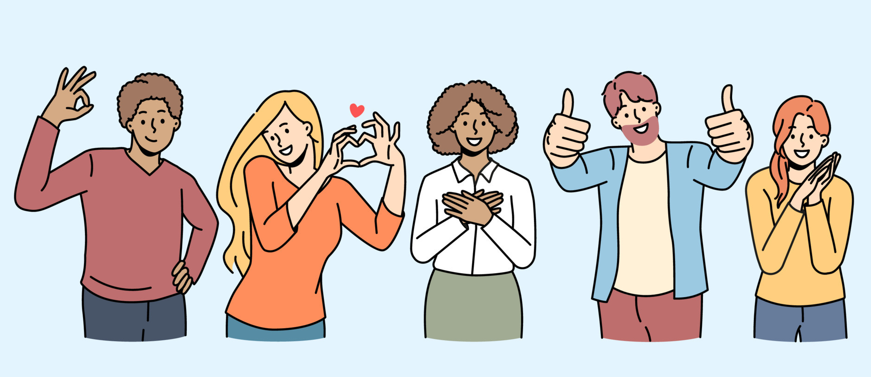Negative and positive body language
Great body language helps salespeople, including pharmacy staff, communicate with their customers, makes them seem more in control and helps to close the sale. But poor non-verbal communication can leave us with egg on our face and could result in frustrated customers who do not engage or buy from us. So, with that in mind, let’s look at some physical postures that we should all try to avoid.
Negative Body Language
Lack of eye contact – Not making eye contact indicates either a lack of interest – or even worse – intent to deceive. That does not mean that you want to get into a staring contest with your customer. It is OK and even desirable to break eye contact periodically, but failing to ever make contact will result in customer distrust.
Selling Belly to Belly – While it is important to be able to make eye contact with your customers, you want to avoid invading their personal space. Stand slightly to the side and keep 18-36 inches between you and the customer.
Touching the Face – This can create a sense of distrust with the customer. In addition, it can be unsanitary and shows poor infection control measures in an environment where infection control is very important.
Unnatural Facial Expressions – You can always tell when someone is forcing a smile, can’t you? So avoid the “painted-on” smile. Instead, make sure you are acting in a genuine manner – after all you should be happy to engage with every customer.
Scratching Your Head – This is a dead giveaway that you either are unconfident in your product knowledge or your recommendation. Instead, keep your hands in front of your body using an open palm to show friendliness.
Folded Your Arms Across Your Chest – This is a big problem because it indicates to customers walking in the door that you do not want to engage with them. If you do it when speaking with someone it can indicate impatience or anger.
Giving the Customer the Finger – We are not speaking about THE finger, but instead the index finger. Imagine that a customer walks up to you and asks you to help them locate something and then you point in that direction and tell them where it is. Aren’t you telling them that they are not very important? Instead, escort them to the product and start a conversation!
Using Your Phone on the Sales Floor – Take a look around the next time you are shopping. Many sales reps are constantly checking their phone, texting or reading email. What are they telling you? That their phone is more important than you are?
Training retail staff on proper body language habits will go a long way toward improving their sales results and your customers’ experience. Evidence shows us that negative body language can reduce sales by as much as 15-25%.
Positive Body Language
By learning how to hold your body and when to make eye contact, you can position yourself as a confident, reliable, and easily approachable professional. Here's some tips on what you can do to demonstrate your best qualities to customers through body language:
1. Maintain eye contact
When you maintain eye contact, customers know you're listening to them and are ready to process any requests or answer their questions. When you're completing a task and a customer approaches you, looking at them helps you recognise the importance of the interaction. While maintaining eye contact, control your facial expressions to express interest and your willingness to help. For example, it's advisable that you refrain from furrowing your brow, as this might signify anger or worry.
2. Nod to show agreement or understanding
Nodding is a highly persuasive element of body language. In customer service, it tells people that you're actively listening to them and taking them seriously. Whenever you're interacting with a customer, nodding can show that you understand their situation or recognise the issue they're facing. For example, you can nod to show customers that you understand their questions.
3. Smile when approaching customers
Smiling is often the first element of nonverbal communication you can use to interact with customers as soon they enter the shop. When customers see a pharmacy staff member with a smile on their face, they're more likely to trust their judgement and opinion. Smiling can also help you extend the customer service promise and show you're truly passionate about your profession in pharmacy.
4. Use hand gestures to make verbal communication efficient
Gestures play an important role in positive customer service. When you're selling goods, you can use your hands and posture to accentuate a product's features and show your enthusiasm which results in a more positive reaction from customers. For instance, you can introduce flowing gestures, like opening your palms and moving them upward, to encourage people to listen to you. Other times, it might be helpful to use your hands to indicate the range of items a customer can purchase in response to their question e.g., what pain killing medications can I purchase?
5. Learn to use different tones of voice
In the service industry, your tone of voice is often the determining factor between delivering positive and negative customer service. To take good care of customers, try using an upbeat but natural tone, which transmits positivity. It's also necessary to recognise the difference between a formal and casual tone when speaking with customers. Learning to adjust your tone to the situation is a sign of professionalism, whether interacting with people face-to-face or talking to customers on the phone.
6. Maintain good posture
Like anything you say or do, your posture can signify professionalism in the workplace. Standing straight, with your shoulders back and your head in line with your body demonstrates openness and makes you look confident. When customers interact with professionals who can easily maintain a good posture and use positive body language, they're more likely to trust their solutions. This helps with building long-lasting relationships and influencing people's purchasing decisions. it also promotes trust and encourages both extra and repeat purchases.
7. Refrain from crossing your arms
In a professional setting, crossing your arms can signify you're unavailable and make customers feel intimidated. As a result, they might avoid asking you questions or starting interactions that might lead to making a sale. Instead, keep your arms by your sides but not in your pockets.
8. Remove distractions
If you interact with people removing distractions can help you concentrate on the customer and their questions. For example an untidy work area and bench can be really distracting but a clean area has the opposite effect.
9. Avoid unnecessary movement
Unnecessary movement, like fidgeting or walking from one side of the room to the other, can make customers feel uncomfortable and seem distracting to them. In extreme cases, it might even signify that you're more interested in another task than helping them. Whenever you're speaking with a customer, remember to stay still and only move your hands. For example, you can subtly point at items you're describing to them.
10. Match your words to your body language
Delivering consistent customer service requires that you learn to match your body language to what you're saying. To create a positive atmosphere, avoid using negative words, including 'no' or 'don't'. Even if you're unable to immediately fulfil a customer request, it's essential that you still demonstrate your willingness to help.
For example, when a customer asks you about a medicine that you don't currently have in stock you can communicate to them that you're awaiting a new shipment. In the meantime, you can propose to the customer that they try an alternative medicine. As you're assisting them, you can also verbally assure them that the new medicine works in an identical way.
11. Stand close but respect personal space
To ensure that customers can hear you clearly, especially if you work in a busy office or store, it's good to make sure you stand close to them. In customer service, it's necessary that both sides feel comfortable during a discussion without raising their voice. Simultaneously, it's advisable to respect customers' personal space. To determine the right distance between you and a customer, you can simply ensure you stand 60 to 90 centimetres from them.
12. Watch your customers' body language
Lastly, in addition to paying attention to how you move, remember to watch your customers' body language. How they stand or speak can tell you a lot about what they're thinking or if you've successfully convinced them to buy something. When reading a customer's body language, see if they're mirroring your facial expressions, maintaining eye contact, or leaning towards you. These are often signs that they're interested in what you're saying, and your sales techniques are effective.


